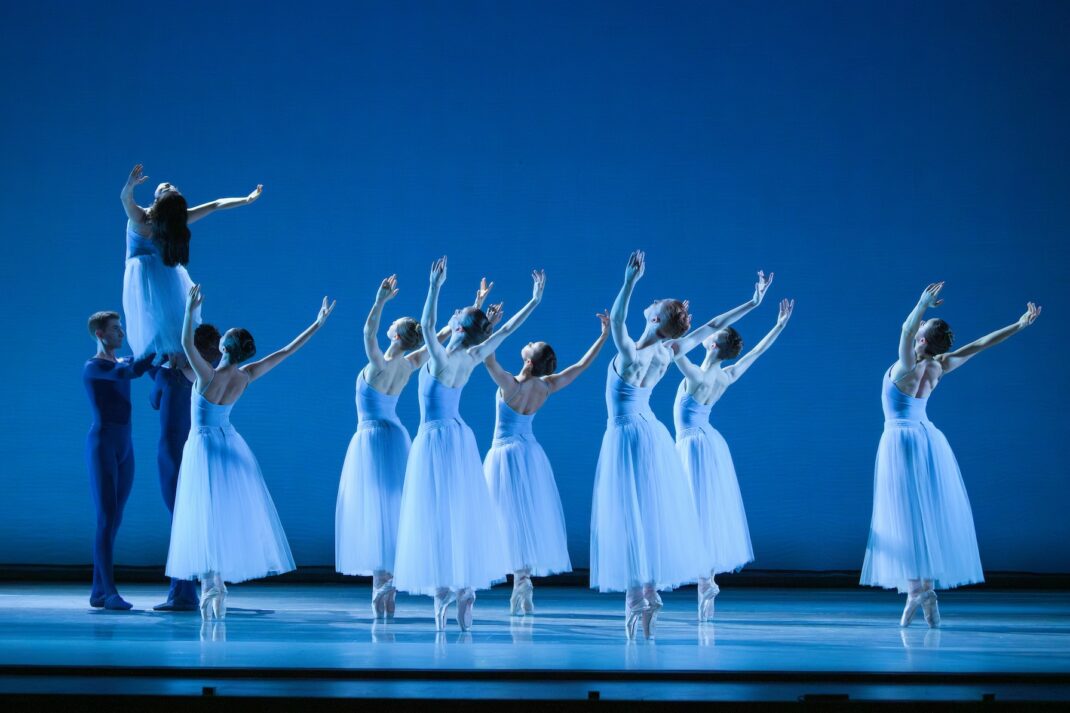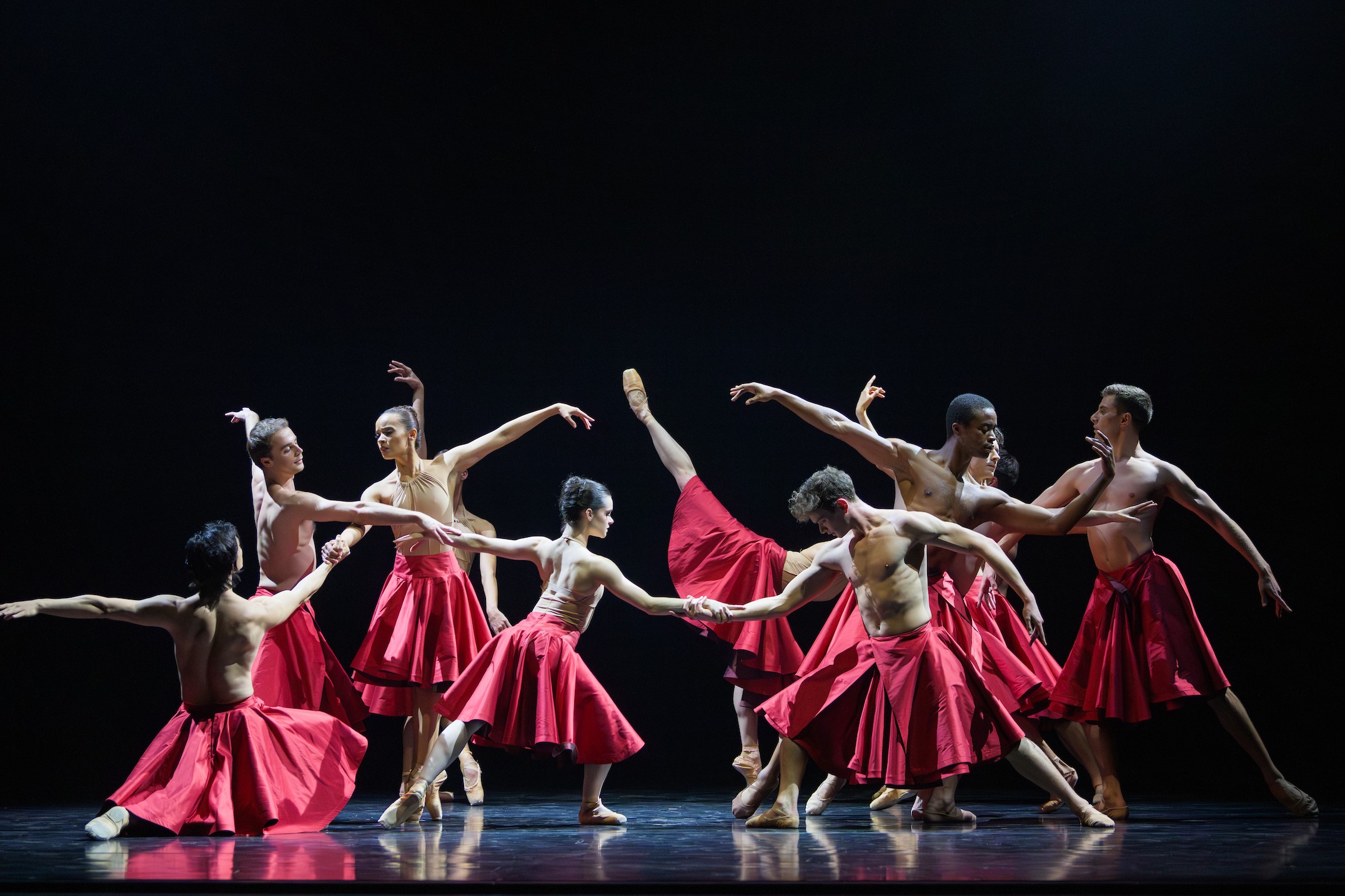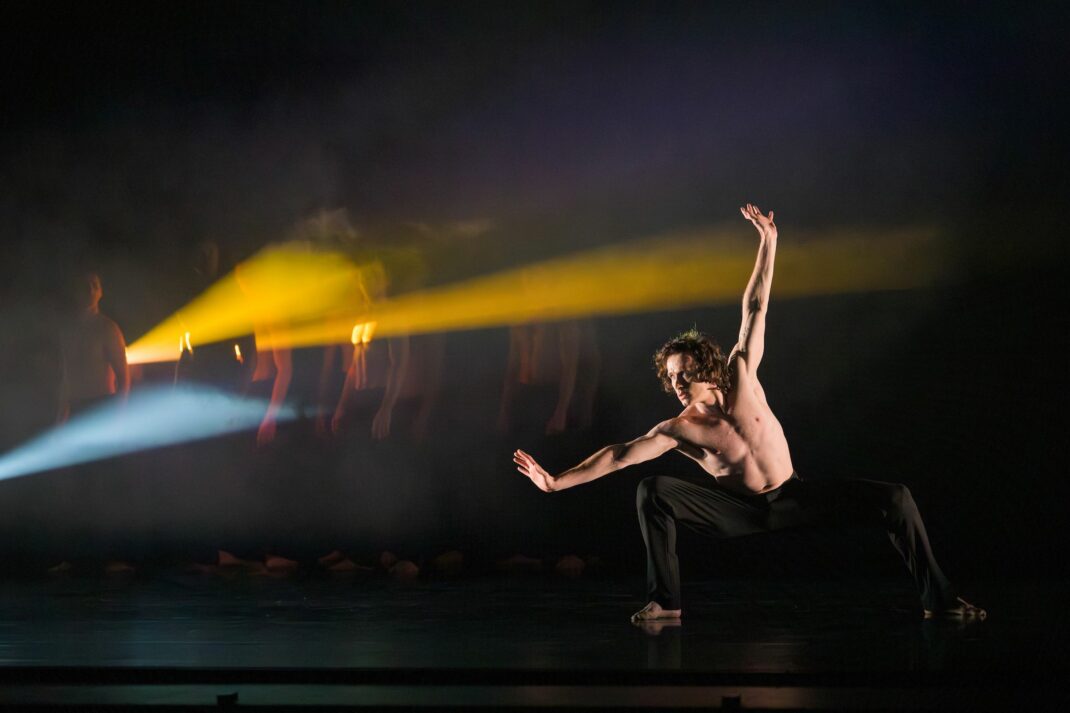27 July, 2023. St. James Theatre, Wellington.
reviewed by Jennifer Shennan
The opening work, Serenade, to Tchaikovsky, is an abstraction of femininity, a favoured topic of Balanchine’s. It was created, in 1934, for students at the School of American Ballet that fed his company, so the memory of several productions at New Zealand School of Dance here across the decades, with the aura of fresh innocence of students at the threshold of their careers, has been special. The work has also been performed a number of times by RNZBallet since the 1970s.
My interest in watching Serenade is always to follow the dancers’ eye and facial expression, which styles the production and invites our response to it. Despite the uniformity of torso movement and port de bras required, some dancers in this cast smiled broadly and looked directly at the audience, whereas others looked into the far or the middle distance, raising the question as to what the performers are thinking about, and how Balanchine himself might originally have styled the work. The twirling pirouettes of tulle skirts always works its special poetry, but the use of token male dancers to lift a female dancer aloft in the closing scene has always seemed anachronistic. Having said that I do know that many balletomanes adore this work, even rate it as their favourite, and I respect that. All the dancers performed with aplomb, but Mayu Tanigaito found a way to invest her abstract movements with a spiritual quality that puts her in a class of her own.

(Harry Haythorne, artistic director here 1982–1993, told me that when a member of Metropolitan Ballet in UK he sustained an injury that put him out of performing for some time. He used the rest period to study Laban’s dance notation, and became fluent enough to score Balanchine’s Serenade, the first notator to do so. Although many versions of the score have since been made, Harry’s was the first, so it is poignant to visit the Dance Notation Bureau in New York and sight the initials HH at the footer of each page of his score.)
The second work, Te Ao Mārama. choreographed by Moss Te Ururangi Patterson, opened with the renowned Ariana Tikau playing pūtõrino, that most distinctive of taonga pūoro (Maori traditional instruments). I would have thought this sound would reach acoustically into every corner of the theatre, since these instruments were traditionally played in open air. I must confess that amplification of it, plus the electric guitar and amplification from Shayne Carter on the opposite side of the stage, made for challenging acoustic contrast. The dance itself explored the theme of moving from Te Kore, the darkness, as though searching for fragments of what would in time grow into haka, traditional dance, into the world of light, Te Ao Mārama. This is an interesting notion, for a choreographer to make a dance about dancing, and the final haka was certainly performed with vigour and intent by the all-male cast. I found various lighting effects, including bright white beams that swept into the audience’s eyes several times, as though to dazzle them, both unpleasant and distracting.
I did welcome the reminders of various incorporations of Maori dance influence into the repertoire of RNZB over their seven decades. Poul Gnatt in 1953 choreographed Satan’s Wedding, which a reviewer at the time (DJCM in The Auckland Star) noted reminded him of the power of haka, which was quite a thrill for Poul to hear. In 1990s Matz Skoog’s and Sue Paterson’s project that combined RNZB with Split Enz music, and Te Matārae ī Orehu on the same program, Ihi FreNZy, made very strong impression—especially when, by way of epilogue, both companies of dancers combined in a rousing haka. By the time that tour ended, Shannon Dawson, one of the strongest character dancers the Company has ever known, seemed to have changed his ethnicity. I doubt if another pākehā has ever performed haka so convincingly. My standout memory though, across all the years, is from Gray Veredon’s Tell me a Tale, set in mid 19th century, in which Warren Douglas led a haka of rage against the young colonial boy (played by Kim Broad), his father (played by Jon Trimmer) and mother (played by Kerry-Anne Gilberd). The boy had dared to fall in love with (Warren’s) sister and that provoked a taparahi never to be forgotten. We could all now haka in rage and sorrow that Warren was taken so young, and we lost a phenomenal dance talent when he lost his life.
The third work, Requiem for a Rose, is choreographed by Annabelle Lopez Ochoa, to Schubert’s String Quintet in C major. There is a depth, beauty and mystery in this piece that resonates, not only as a flower of romance, but with what the rose has meant as symbol of life and love, to different peoples and cultures in history, across stories, poems and paintings—originally from Persia, China, India, South America, and then worldwide. Twelve dancers, male and female, wear rich red circular skirts that seem almost fragrant when illuminated by Jon Buswell’s outstanding lighting design. They dance a series of four duets and a quartet, all very well cast, and beautifully set to the music. The 13th dancer, Kirby Selchow, wearing the barest of leotards and no skirt, carrying a red rose in her mouth throughout, powerfully sustains the essence and mystery at the heart of this enigmatic and beautiful work.

The fourth work, Logos, choreographed by Alice Topp, is to a very effective commissioned score by Ludovico Einaudi. The opening duet, by Mayu Tanigaito and Levi Teachout—and the closing duet, by Ana Gallardo Lobaina and Matthew Slattery, are equally exquisite though in very different ways. (In later solo sections Teachout seemed to have found an astonishing quality of torso movement that evokes the likes of choreography we have seen from Douglas Wright dancers—which made him a standout in a cast of already strong dancers.) There are a number of quotations oddly laid out in the program notes, but I guess that matters not as simply following and absorbing the dance as it progresses from a dark and troubled beginning to a clearer lighter place was all the guidance we needed. Topp and Buswell collaborated brilliantly in the design for this work. Its apotheosis is a theatrical coup, and one that will stay with all who see it, even as it suggests what some might see as a disturbing harbinger for the planet. A powerful work of theatre with much to admire.

There is an exhibition in the theatre foyer to mark this as the 70th year of the Company. There are many wonderful images that remind us of a rich and varied repertoire across the decades. A National Film Unit documentary, with footage from 1959–1962 performances, is screening within the exhibition, and is a treasure. My favourite vignette in this film has always been of Jacqui Oswald Trimmer dancing in Do-Wack-a-Do, composed by the legendary Dorothea Franchi. Jacqui would have won a role in The Great Gatsby if she had used this as her audition piece. Gloria Young, Sara Neil, Anne Rowse, Patricia Rianne, Terence James, Carol Draper, Christine Smith, Valerie Whyman, Kirsten Ralov and Fredbjörn Björnsson all make striking cameo appearances in the film, and the alumnae gathering for celebrations will have great fun in following them all.
There is much to savour in the storyboards, but one statement cannot go unchallenged. Friends of the New Zealand Ballet was formed by Poul Gnatt in 1953 (not some decades later as stated). Without those subs from Friends in the 1950s, this company would simply not have made it round the country. Poul used to drive the truck with scenery and costumes from town to town to town—pick up every hitch-hiker he spied, and by the time the hikers climbed down from the truck at the end of the ride they were subscribed members of Friends of the Ballet. Poul used the money to buy petrol to drive the truck to the next town. It’s an important story—because when Poul a decade later returned to his native Denmark he taught colleagues at Royal Danish Ballet that they too should set up a Friends—which they named Ballet Appreciation Club. It has survived to this day with a staggering number of audience education and outreach activities. If they remember that Poul showed them how a Friends outfit can work, we should surely remember that too.
Jennifer Shennan, 29 July 2023
Featured image: scene from Te Ao Mārama. Royal New Zealand Ballet, 2023. Photo: © Stephen A’Court.


Thanks Jennifer
Thanks Matz. It’s so good having Jennifer back reviewing RNZB productions. Let’s hope it continues once the new director steps up.
Michelle